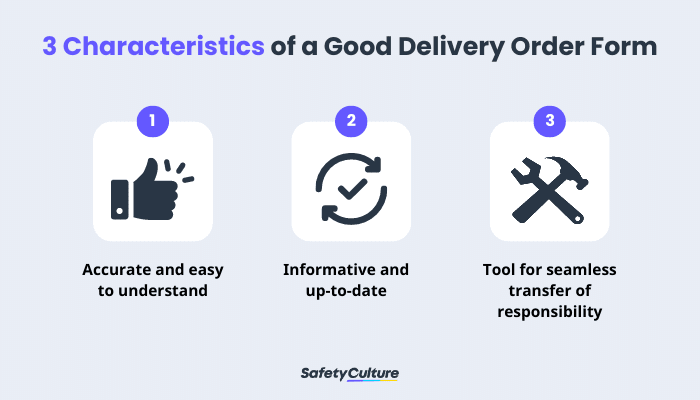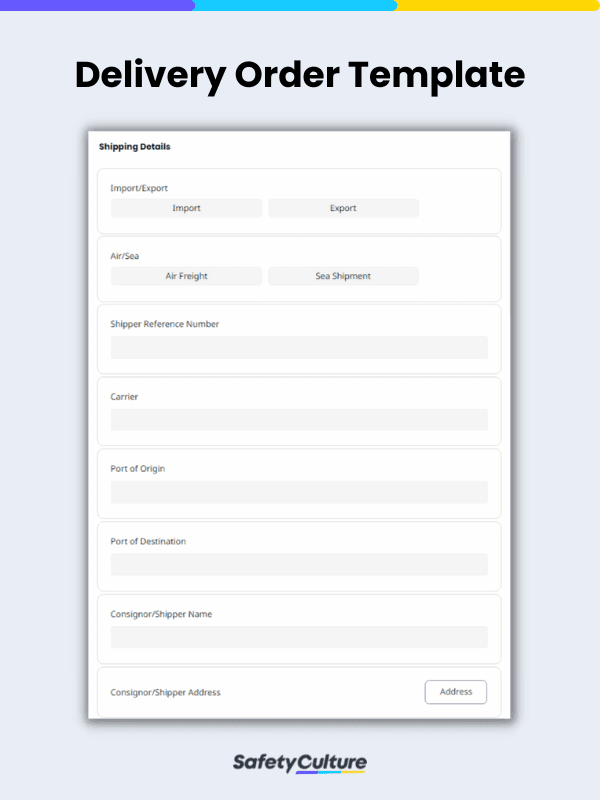What is a Delivery Order Template?
A delivery order template is used to relay instructions to freight forwarders regarding shipments and delivery details. It can also be used as proof of shipment and a record of accountability from carrier to forwarder. A clear and accurate delivery order form helps avoid costly delays and delivery errors that could hurt the shipper’s reputation.
Benefits
Choosing to use ready-made templates offers a lot of benefits for businesses and individuals that need to send out orders for delivery. First, there’s a time-saving opportunity since predesigned structures of delivery order templates are available. Individuals don’t have to create them from scratch for each use. This allows them to use their time and effort to do other important things that need attention.
Second, it promotes consistency. Templates ensure that each delivery order contains the same essential information, which helps users avoid errors and inconsistencies. It also streamlines the order fulfillment process by providing a standardized delivery order format that can be easily shared among team members.
Finally, maximizing templates, especially digital ones, eases the documentation process. If all information is saved in one secure location and accessible to authorized team members, it can greatly improve the inventory management process. This then provides businesses with the correct information at all times, assuring accuracy in delivery orders and increasing customer satisfaction.
What to Include in a Delivery Order Template
Delivery order templates contain mandatory information intended to facilitate the delivery of shipments. With some variations depending on the method of shipment, here are the crucial elements of a delivery order and a typical delivery order format:
Consignor
Also called “shipper,” this individual or organization is responsible for initiating the delivery order. A delivery order form includes the shipper’s name and address.
Consignee
The recipient of the shipment. A delivery order form includes the consignee’s name and delivery address.
Reference numbers
This is used to track the status of the shipment. Reference numbers may vary based on the mode of transport used.
Carrier
This refers to the mode of transport used, which can be either by sea or air.
Port
This identifies the port of origin and the port of destination. The port of origin is where the shipment is loaded to the carrier, while the port of destination is where the shipment is unloaded. The port of destination can be different from the delivery address or the final “place of destination.”
Delivery date
This is the date when the shipment is to be delivered to the consignee.
Shipment details
This contains details such as the number of pieces, volumetric weight, dimensions, and volume of the shipment. This may also include special instructions from the shipper.
3 Characteristics of a Good Delivery Order Form
To help ensure that shipments arrive safely and on time at the correct address, delivery orders should be:

- Accurate and easy to understand
The information on the delivery order should be clear and easy for the crew to read. Multiple shipments go all over the world round-the-clock, and an accurate delivery order prevents errors or delays caused by the need for clarification. - Informative and up-to-date
There are a lot of variables that can delay shipments and affect their condition while in transit. Changes in the delivery date and address, for example, should always be updated on the issued delivery order form. Unsuccessful deliveries caused by incorrect information can leave a negative impression on customers and business partners. - An effective tool for the seamless transfer of responsibility
As proof of transfer of responsibility, delivery order forms should be made available for all parties involved. Technology has allowed the use of digital delivery order templates to provide information to the crew, saving time and preventing costly delays.
How to Write a Delivery Order
Creating a delivery order is quite a simple process and it typically consists of the following steps:
- Add all essential information, such as the customer’s details, reference number, important dates and times, and the contact information of the delivery note issuer.
- Include specific shipping details such as the type of transportation, carrier, and ports of origin and destination.
- Provide a detailed description of the items being delivered and their shipment details, including the number of pieces, weight, dimensions, and volume.
- Add special instructions in the space provided, if applicable.
- Attach an image or images as proof of delivery and increase the quality of your delivery order form.
Businesses can create delivery orders from scratch, but they can also leverage pre-made templates that are not only ready-to-use but also customizable to suit specific business needs.
FAQs About Delivery Order
The purpose of a delivery order is to provide clear instructions to the carrier or logistics company responsible for transporting goods from their origin to their final destination. It helps facilitate the smooth and timely movement of goods while providing precise and accurate information to all parties involved.
The main difference between a delivery note and a delivery order is that the former is used to verify the receipt of goods by the buyer. The latter, on the other hand, is used to instruct the carrier or logistics company on the movement of goods from one location to another.
The delivery order is prepared by the party responsible for shipping the goods. This could be the supplier, manufacturer, distributor, or any other entity responsible for getting the goods from one location to another.


